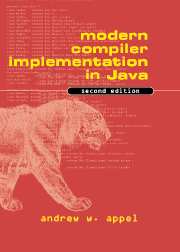Book contents
- Frontmatter
- Contents
- Preface
- Part I Fundamentals of Compilation
- Part II Advanced Topics
- 13 Garbage Collection
- 14 Object-Oriented Languages
- 15 Functional Programming Languages
- 16 Polymorphic Types
- 17 Dataflow Analysis
- 18 Loop Optimizations
- 19 Static Single-Assignment Form
- 20 Pipelining and Scheduling
- 21 The Memory Hierarchy
- Appendix: MiniJava Language Reference Manual
- Bibliography
- Index
20 - Pipelining and Scheduling
from Part II - Advanced Topics
Published online by Cambridge University Press: 05 June 2012
- Frontmatter
- Contents
- Preface
- Part I Fundamentals of Compilation
- Part II Advanced Topics
- 13 Garbage Collection
- 14 Object-Oriented Languages
- 15 Functional Programming Languages
- 16 Polymorphic Types
- 17 Dataflow Analysis
- 18 Loop Optimizations
- 19 Static Single-Assignment Form
- 20 Pipelining and Scheduling
- 21 The Memory Hierarchy
- Appendix: MiniJava Language Reference Manual
- Bibliography
- Index
Summary
sched-ule: a procedural plan that indicates the time and sequence of each operation
Webster's DictionaryA simple computer can process one instruction at a time. First it fetches the instruction, then decodes it into opcode and operand specifiers, then reads the operands from the register bank (or memory), then performs the arithmetic denoted by the opcode, then writes the result back to the register back (or memory), and then fetches the next instruction.
Modern computers can execute parts of many different instructions at the same time. At the same time the processor is writing results of two instructions back to registers, it may be doing arithmetic for three other instructions, reading operands for two more instructions, decoding four others, and fetching yet another four. Meanwhile, there may be five instructions delayed, awaiting the results of memory-fetches.
Such a processor usually fetches instructions from a single flow of control; it's not that several programs are running in parallel, but the adjacent instructions of a single program are decoded and executed simultaneously. This is called instruction-level parallelism (ILP), and is the basis for much of the astounding advance in processor speed in the last decade of the twentieth century.
A pipelined machine performs the write-back of one instruction in the same cycle as the arithmetic “execute” of the next instruction and the operand-read of the previous one, and so on. A very-long-instruction-word (VLIW) issues several instructions in the same processor cycle; the compiler must ensure that they are not data-dependent on each other.
- Type
- Chapter
- Information
- Modern Compiler Implementation in Java , pp. 440 - 463Publisher: Cambridge University PressPrint publication year: 2002



